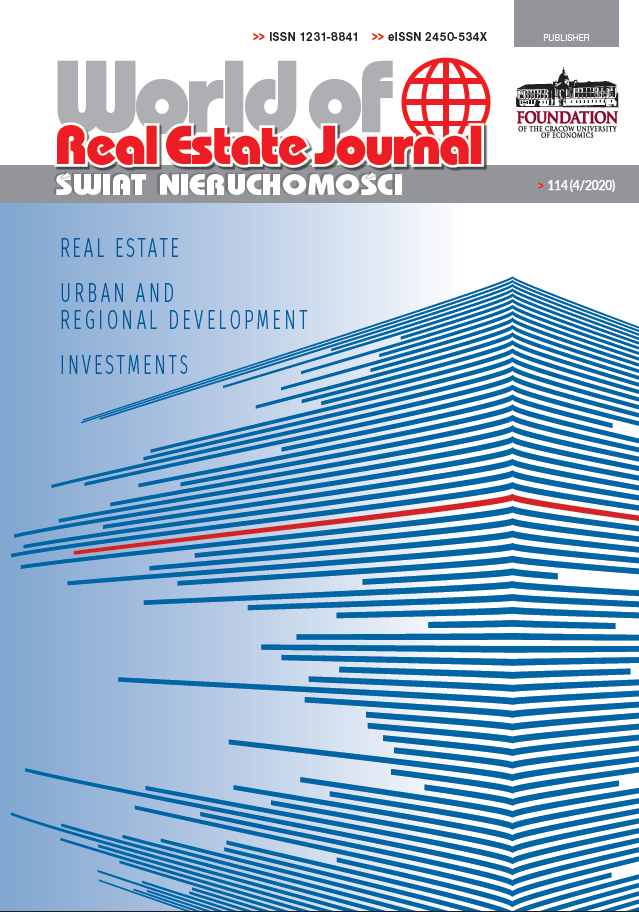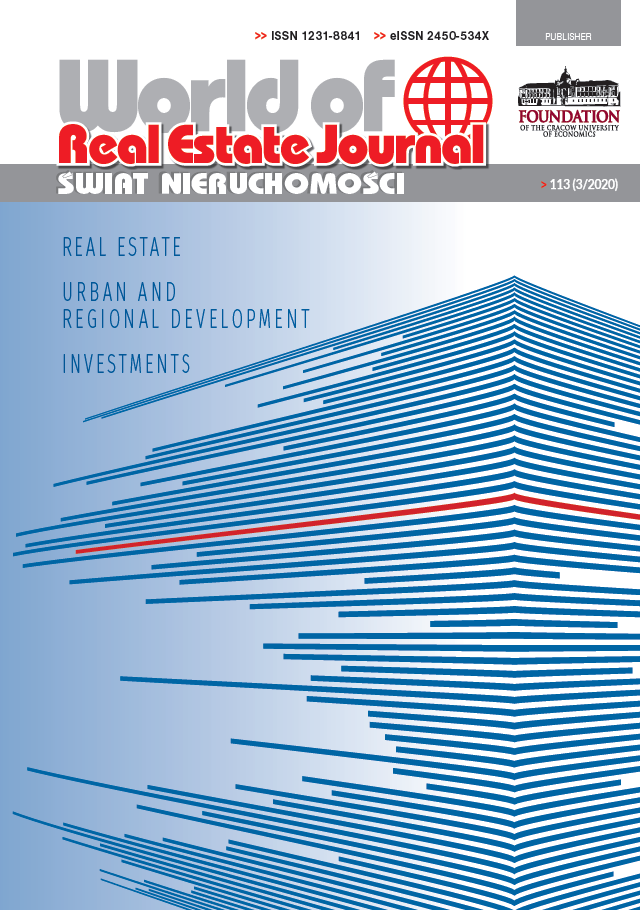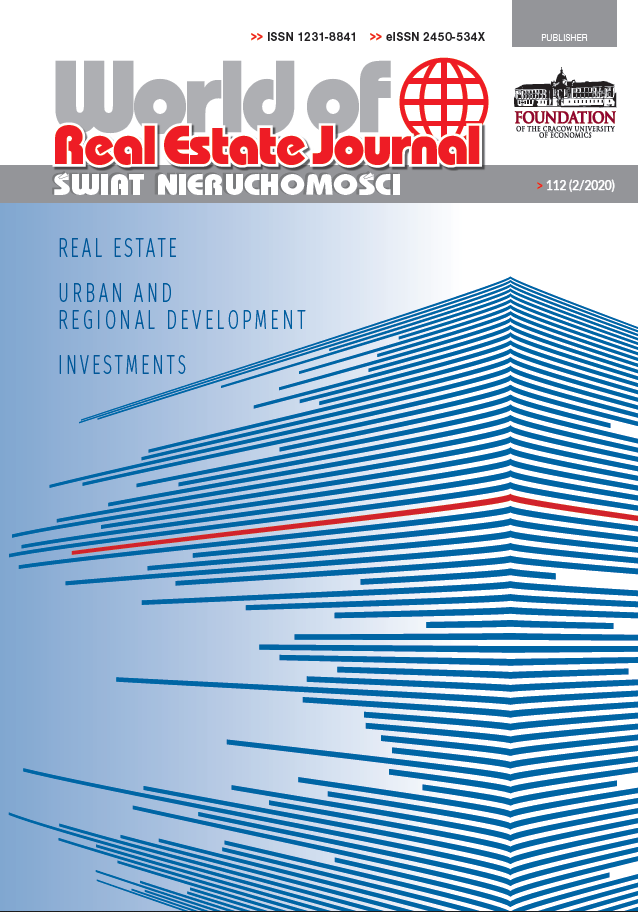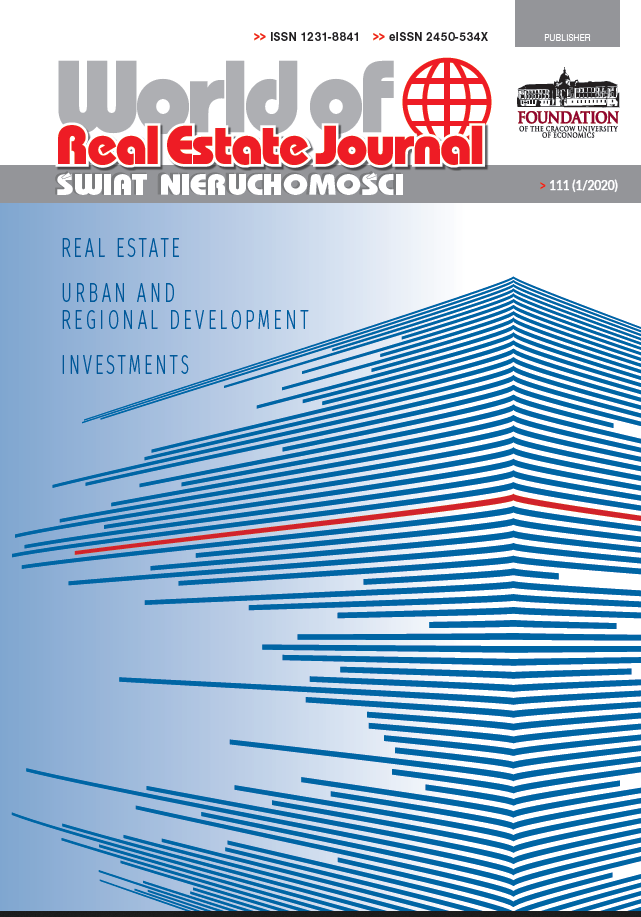REAL ESTATE MANAGMENT
1) Maciej W. Wierzchowski – Forecasting financial impacts of zoning plan
2) Maciej J. Nowak, Janina Kotlińska - Rates of housing real estate tax – significance for the local economy
3) Dariusz Felcenloben - Tasks and functions of the real estate cadastre
MARKET
4) Elżbieta Gołąbeska - Economic fluctuation on the real estate market
5) Barbara Stolińska - The foreigners’ interest of purchasing real estate in Poland in 2009
6) Filip Hartwich - Purchasing Real Estate by Foreigners in the European Union countries
FINANCES
7) Krzysztof Drachal - Perspectives of introducing reverse mortgage in Polish conditions
8) Grzegorz Strupczewski - The scope of flood risk insurance of houses offered by Polish insurance companies
9) Edward Wiszniowski - Using market value of the real estate in the examination of credit risk according to recommendation S (II) of The Financial Supervision Authority
INVESTMENTS
10) Edyta Plebankiewicz, Agnieszka Leśniak – Questionnaire survey applying to overheads and profit in estimating a total cost of project
CHANGES IN REAL ESTATE LAW
11) Maciej J. Nowak - Combating the effects of flooding in real estate law DOWNLAND
CONFERENCES
12) Anna Harańczyk, Patrycja Brańka - Scientific Conference "Regional Policy in Poland in the light of the challenges of the XXI century" - (Krakow, 24 - 25 June 2010) DOWNLAND
13) Andrzej Jaki - XIV International Scientific Conference "Restructuring in the face of new economic challenges. Management - Strategy - Analysisę (Krynica Zdrój, 13 - 16 October 2010) DOWNLAND
14) Michał Głuszak - Scientific Conference"Localreal estate markets- state, trendsof development,test methods" (Poznan, 24 September 2010) DOWNLAND
WORLD OF REAL ESTATE JOURNAL 2010
15) Table of Contents 2010 DOWNLAND
SUMMARIES
Maciej W. Wierzchowski - Forecasting financial impacts of zoning plan
The article presents the author’s preferred methods for analyzing and evaluating the financial consequences of adoption of the zoning plan, using the simulation method, taking into different ways:
a. methods for defining the current market value of real estate;
b. mathematical formulas;
c. determinants of the capital market.
The advantage of such a prediction, constitutes its inherent characteristic, experiment simulation is the repetition of in the same conditions (carried out using the same assumptions). This method allows you to:
• prompt and clear verification of the results,
• comparison of obtained results with those obtained using alternative, even competitive, solutions
The article focuses on the forecasting methods that can be applied in practice by planners in the process of assessing the financial impact of the adoption of a local zoning plan. They are:
a. intuitive methods;
b. methods of successive approximations;
c. taxonomic methods.
Maciej J. Nowak, Janina Kotlińska - Rates of housing real estate tax – significance for the local economy
Paper presents role of estate tax in dwelling local economy in the biggest polish cities in 2006 – 2009 years. Analysis shows that the most important are rate of the role of estate in cities like Bydgoszcz and Zielona Góra. In biggest cities in Poland local dwelling – tax economy is not as important. In article besides were used statistic implements.
Dariusz Felcenloben - Tasks and functions of the real estate cadastre
Building and maintaining an effective system of property management depends largely on the efficiency of institutions of the real estate cadastre, which has specific tasks assigned by the legislator and clearly indicated areas where the cadastral data disclosed therein, shall constitute a determining basis for other decision-making procedures both in public administration circles and outside them, which is related more broadly, for example to the property market and the processes associated with it. In this context, in the presented article, were defined tasks, principles and functions of the real estate cadastre, which it is performing in law, management systems, social acceptance and as a public register.
Elżbieta Gołąbeska - Economic fluctuation on the real estate market
The analysis of the Polish real estate market transformation processes proves that the occurring changes have been the outcome of the external factors’ impact. The economic fluctuations on the real estate market are tightly connected with the activity of the whole economy. Observations indicate that the real estate market development, similarly to the development of other economy sectors, is of cyclical nature. It can be stated that this market behaves in a pro-cyclic way, however with slight delay in relation to the whole economy cycle. Among other things, it is connected with mortgage interest rate and the behaviour of market participants, no matter whether individual or institutional purchasers, for whom real estate purchasing is a kind of investment. Similarly, when the economic activity slows or recession develops the failure on the Real estate market occurs with a slight delay. The connection between economic trends and the trends of the real estate market is undeniable. It can be stated that phases of the economic trends’ cycles and those of the real estate market have similar patterns. The purpose of this article is to present selected aspects of the theory of economic fluctuations’ cycles as well as to prove validity of their use in the estate market analysis, which undoubtedly supports investment processes on this market based on its development forecast.
Barbara Stolińska - The foreigners’ interest of purchasing real estate in Poland in 2009
Real estate acquisition by foreigners in Poland is regulated by the Law of 24th March 1920 on the purchase of property by foreigners. This article shows the interest of foreigners to purchase property in Poland. Moreover the article takes into account the general information about formal considerations – or legal matters related to trade in real estate with the participation of foreigners. The main purpose of this article is to analyze the scale of the foreigners’ interest in purchasing property in Poland based on data collected by the Ministry of Internal Affairs and Administration for the year 2009.
Filip Hartwich - Purchasing Real Estate by Foreigners in the European Union countries
Restrictions in real estate purchases of foreigners are common in many countries. Therefore the Polish case is no exception. The regulations in different countries reach from a compulsory registration of the purchase in a given public office, to a complete ban of real estate purchases. The restrictions may affect certain regions of the country, certain kinds of property, and certain uses of the realty or may affect all kinds of property in the country’s territory as a whole. The article presents the regulations of real estate purchases with foreigners involved in the countries of the European Union.
Krzysztof Drachal - Perspectives of introducing reverse mortgage in Polish conditions
Health care system in Poland and health expenditures in Poland were analyzed. The situation was compared with some other OECD countries. Demographical forecasts were stated and take under consideration in case of future social structure of Polish citizens. Also current law situation was described as environment for a reverse mortgage. On that account the analysis of a financial product was made.
Grzegorz Strupczewski - The scope of flood risk insurance of houses offered by Polish insurance companies
The article presents a research conducted on domestic non-life insurers selling fire and property damage insurance for private individuals – total 24 institutions surveyed. The comparative study of general insurance terms has focused on the issue of covering flood risk in a property insurance. Special attention has been put on flood definitions, flood risk coverage availability in basic or extended cover, additional stipulations and exclusions, list of possible insurable objects.
Edward Wiszniowski - Using market value of the real estate in the examination of credit risk according to recommendation S (II) of The Financial Supervision Authority
In December 2008 Financial Supervision Authority (KNF) has adopted Recommendation S (II) concerned with good practices in the credit exposures secured by mortgages. This act, which is a set of recommendations for banks, regulates the rules for identification, management and supervision of credit risk derived from credit exposures secured by mortgages. The article points out weaknesses in Recommendation S (II) associated with the definition of LtV ratio, which is one of the indicators of the credit risk scale and considers the possibility of clarifying the KNF recommendations.
Edyta Plebankiewicz, Agnieszka Leśniak - Questionnaire survey applying to overheads and profit in estimating a total cost of project
The paper presents results of a questionnaire survey applying to ways of defining overheads and profit carried out among Polish contractors. The purpose of the research was recognizing current methods and principles of indirect cost and profit estimating. As well as comparing them with results of carried out in 2004 similar research.





















































